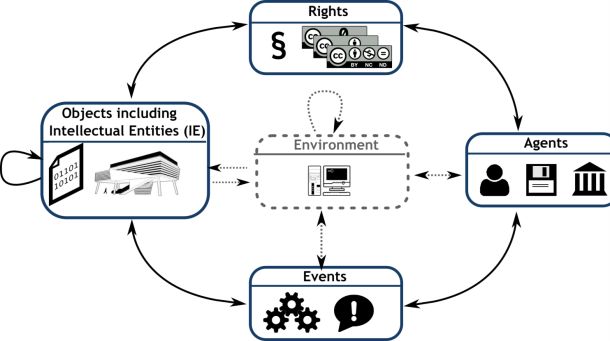Authors: Angela Dappert, Karin Bredenberg, Micky Lindlar, Tracy Meehleib, PREMIS Editorial Committee
When asking a room full of digital preservationists whether they know PREMIS, most will raise their hand. Most understand key concepts including Objects, Rights, Events and Agents. But open questions remain for them and we need to support new practitioners. The PREMIS Editorial Committee wants to make PREMIS approachable and make it easier for people to understand and use preservation metadata. What kind of materials are people looking for? Short webinars on specific issues? Longer tutorials? Implementation stories? A short live survey gave us insight into the community’s needs.
PREMIS is the de facto standard for digital preservation metadata. It captures technical, provenance, rights, and platform information that is needed to ‘ensure the viability, renderability, understandability, authenticity, and identity of digital objects in a digital preservation context’[1].
PREMIS is widely adopted in open-source, commercial and in-house developments. It has reached a high level of maturity. Version 3.0 was released in 2015. It has proven to be stable and to be doing what it is supposed to: Defining digital preservation metadata that ‘most preservation repositories need to know to preserve digital materials over the long term‘.
One of the main tasks for the PREMIS Editorial Committee is to help the digital preservation community adopt and use the standard. 
At We Miss iPres 2020, we conducted an interactive survey to find out what the community would like to learn about PREMIS, and how they would like to learn it. It was a unique opportunity to get up-to-date feedback from 65 respondents within 10 minutes and reach many more attendees. We will use the feedback we gathered as a basis for future outreach activities.
Firstly, we wanted to assess what types of digital materials our user base wishes to preserve. The results were surprising. Around 90% of the survey contributors are preserving each: audio visual materials, text, and 2D image materials. While AV materials seem for many to make up slightly fewer top-priority items in the collections, they nonetheless need the same mature preservation solutions. Even web archives, data bases and software preservation were of concern for around 70% of respondents. We will consider this when we develop outreach materials supporting their specific preservation needs.
Firstly, we wanted to assess what types of digital materials our user base wishes to preserve. The results were surprising. Around 90% of the survey contributors are preserving each: audio visual materials, text, and 2D image materials. While AV materials seem for many to make up slightly fewer top-priority items in the collections, they nonetheless need the same mature preservation solutions. Even web archives, data bases and software preservation were of concern for around 70% of respondents. We will consider this when we develop outreach materials supporting their specific preservation needs.

PREMIS can be used in multiple ways. It can be used as a basis for developing the needed conceptual models - that is the definition of the objects, events, rights, agents, and computing environments that describe our preservation efforts, as well as the relationships between them. About 40% of respondents chose this as their most important use of PREMIS. And about 20% each identified their primary PREMIS uses in implementing customized in-house as well as in off-the-shelfsystems. And of course, many will use PREMIS for multiple purposes. Depending on the way in which it is used, digital preservation staff will need different levels of training. Providing metadata for use in off-the-shelf systems, for example, requires a less deep understanding of metadata modelling than customised use does. Outreach materials need to reflect this.
When asked which aspect of PREMIS people would like to understand better, the top item chosen was conformance with PREMIS. People see compliance with the standard as one type of assurance that their implementation satisfies a desirable quality standard. The PREMIS Editorial Committee has created a conformance statement[2]. But clearly, we need to develop materials that enable users to better assess the level of conformance of their implementations. People also requested a deep dive into aspects of the data dictionary, as well as practical how-to-get-started guides. The emphasis seems to be on information that directly supports practical, concrete implementability. One respondent said “The more concrete and practical you make things, the better. We are onboarding young staff with no background in or prior knowledge of preservation.” This again reflects the level of maturity the standard has achieved. Not too long ago we used to be asked for more theoretical, introductory materials.
People also wanted to discuss how PREMIS can be integrated with other metadata standards and systems, what problem-specific best practices are in use, and share real-life implementation stories. This is where we can support each other and develop a mutual consensus of best metadata practice for digital preservation sub-domains. One of the activities we would like to pursue over the next year is to run short webinars on specific issues (specific digital content types, system integrations, modelling choices, implementation choices, etc.).
 This is a call to action: Please email Angela angela.dappert@gmail.com if you would be willing to work with us to run a short webinar presenting your solution or presenting specific open questions, followed by discussion with other practitioners! Please also email me if you would like to see us run a webinar on a specific issue. The Editorial Committee can then try to organise an event directly around your needs!
This is a call to action: Please email Angela angela.dappert@gmail.com if you would be willing to work with us to run a short webinar presenting your solution or presenting specific open questions, followed by discussion with other practitioners! Please also email me if you would like to see us run a webinar on a specific issue. The Editorial Committee can then try to organise an event directly around your needs!
Covid-19 restrictions on travel and meetings have reshaped the way we want to exchange information. This year, the top requests were for how-to guides / checklists followed by webinars, wiki / FAQs, short videos, and blogs. The emphasis seems to be on bite-size material that helps to directly answer open design and implementation questions. Feedback in previous years emphasised face-to-face tutorials, implementation fairs and workshops.
To that end we want to develop secondary materials (checklists, FAQs, videos) extracted from the planned webinars mentioned above, which can then be used asynchronously whenever they are needed. They can supplement our ever-popular /premis-3-0-final.pdf, website, “Understanding PREMIS”, “Digital Preservation Metadata for Practitioners. Implementing PREMIS" book, “Guidelines for PREMIS within METS”, slides from PREMIS tutorials, and “Conformant Implementation of the PREMIS Data Dictionary"[3].
We look forward on working with you on this.
[1] PREMIS Editorial Committee (2015) PREMIS data dictionary for preservation metadata, version 3.0. http://www.loc.gov/standards/premis/v3/premis-3-0-final.pdf. Accessed 09 October 2020
[2] PREMIS Editorial Committee (2010) Conformance implementation of the PREMIS data dictionary, October 2010. http://www.loc.gov/standards/premis/premis-conformance-oct2010.pdf. Accessed 09 October 2020
[3] https://www.loc.gov/standards/premis/. Accessed 09 October 2020
